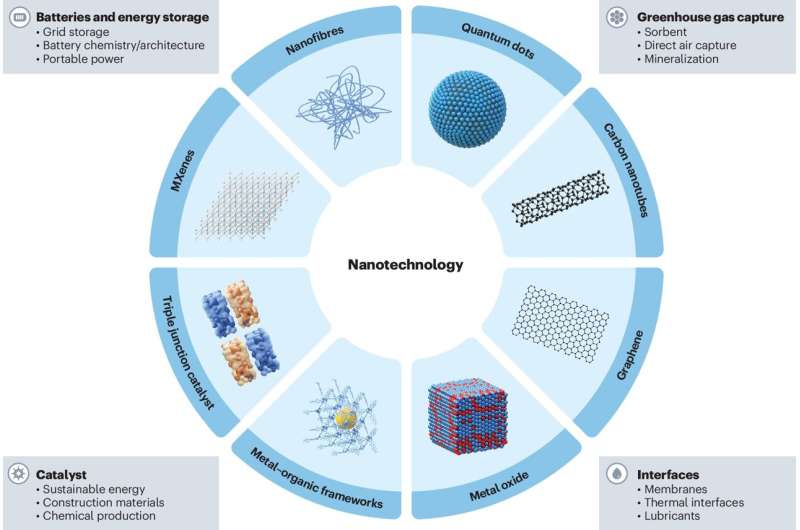
October 15, 2024 by Lawrence Goodman, National Institute of Standards and Technology
Collected at: https://phys.org/news/2024-10-qa-nanotechnology-climate.html
When we think about the climate crisis, we tend to think big—it’s a global problem that requires global solutions.
But NIST scientists James Warren and Craig Brown also want us to think small, very small. They’re thinking at the nano-level, which is anywhere between 1 and 100 nanometers. That’s about 1,000 times smaller than the width of a human hair.
In a paper just published in Nature Nanotechnology, which they co-authored with other federal government, industry and private foundation researchers, they call for a greater focus on nanotechnology‘s potential role in combating climate change.
The study was done under the auspices of the National Nanotechnology Coordination Office, whose Nano4EARTH initiative aims to use nanotechnology to address climate change. Warren and Brown were asked to participate because of their backgrounds in developing new materials into manufactured products and their expertise in nanoscale structure and measurements.
The authors note that to avoid the most dire impacts of the climate crisis globally, we must significantly reduce our emissions by 2030—and hopefully reach net-zero emissions by 2050.
“There is a unique opportunity for nanotechnology to contribute to this goal. … Urgent action is needed to rapidly scale up and implement new climate solutions, drawing insights from successful nanotechnology applications,” the authors wrote.
NIST spoke with Warren and Brown about the role nanotechnology could play in protecting the environment.

Why did you feel it was important to write about nanotechnology and climate change?
Warren: We really wanted to get people to start thinking about what steps are possible with nanotechnology to help address the climate crisis. We certainly feel that there’s a lot that could be done that isn’t being done. This is really a call to action.
What role could nanotech play in reducing industry’s greenhouse gas emissions?
Brown: The International Energy Agency says industries need to reduce emissions by two gigatons of carbon dioxide (CO2) per year globally by 2030. (A gigaton is equal to 1 billion metric tons, roughly the weight of the weight of 2 billion adult African elephants.)
One way to do this would be through green hydrogen, in which hydrogen is produced using renewable energy with no emissions. Industries could use green hydrogen as an alternative fuel source or a replacement for fossil fuel-based chemicals, such as gas and oil used in the manufacturing process.
Right now, it’s expensive to produce green hydrogen. Nanocatalysts could greatly reduce the cost.
What do you mean by nanocatalysts?
Brown: The advantage of nanomaterials is that they have much higher surface areas than regular materials. Imagine taking a cube and dividing it into 1,000 cubes. You’ve exposed many more surfaces. This, in turn, increases the number of sites where reactions can take place.
It works the same way with nanomaterials, where nano-sized particles can be shaped and arranged to maximize the number of potential reaction sites.
Catalysts are used throughout the green hydrogen production process. A catalyst often becomes more effective when it has more surface area, so by using a nanocatalyst, you can speed up and scale up the process. This can also potentially cut costs and make the processes more energy efficient.
What role can nanotechnology play in carbon capture?
Warren: Direct air capture facilities are being built worldwide to remove CO2 from the atmosphere. They typically use giant fans to suck in air, which is then pushed through a filter that captures or traps carbon molecules, effectively removing them from the environment.
Some of these filters are like sponges that selectively trap CO2 in their pores. The pores in these materials are typically in the nanometer range, which provides a high surface area for CO2 capture. The goal is to make sure the filter is selective and works effectively at capturing CO2 within the pores.
You talk about using nanotechnology on windows to make buildings more energy efficient.
Warren: People are probably familiar with some of the coatings available now that selectively filter different types of sunlight. They work by allowing visible light to pass through while blocking certain wavelengths of infrared light that generate heat inside a house or building.
These are called chromic nanocoatings, and they contain nano-sized particles that can absorb, reflect or transmit different wavelengths of light in much more complicated ways. They can change color or transparency in response to temperature or the amount of sunlight—perhaps darkening to keep the sun out of a house at peak midday heat to keep the people inside cool without having to crank up the air conditioning.
A recent research paper said chromic windows controlled by electricity, known as electrochromic windows, have the potential to save up to 40% of energy demand for building heating and cooling.
How achievable are all these nanotechnologies?
Warren: The challenges range in technical difficulty. Some likely take concerted investments, while others require significant scientific and engineering innovations. Still, even though there are significant economic barriers to transitioning away from existing solutions, the payoffs to human welfare are ample compensation.
More information: Maria Fernanda Campa et al, Nanotechnology solutions for the climate crisis, Nature Nanotechnology (2024). DOI: 10.1038/s41565-024-01772-5
Journal information: Nature Nanotechnology

Leave a Reply